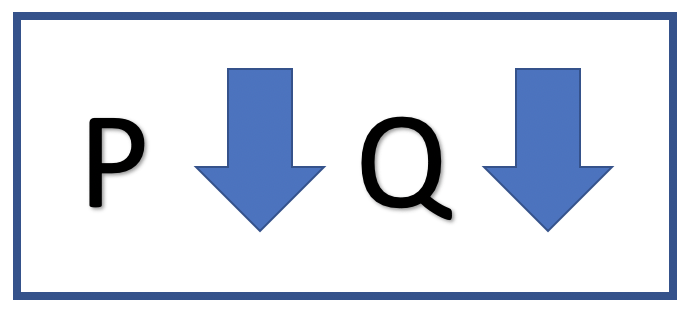Movements along a supply curve is movement caused by a change in price, assuming all other variables are held constant.
Since we are discussing supply, let's look at the supply schedule of a producer--in this case, a farmer who is supplying apples to the market.
Notice the relationship between price and the quantity, in thousands of bushels, that he is willing to supply.
| Price of Granny Smith Apples | Quantity of Granny Smith Apples Each Week |
|---|---|
| $2.00 | 7 |
| $1.75 | 6 |
| $1.50 | 5 |
| $1.25 | 4 |
| $1.00 | 3 |
| $0.75 | 2 |
| $0.50 | 1 |
| $0.25 | 0 |
Notice that if the price per apple was $2, which is quite an expensive apple, the farmer is willing to produce a large quantity because he knows that he can make a lot of money.
However, as the price starts to fall, he is willing to supply a lower and lower quantity of apples.
Let's look at the supply graph, if we plot these points with price on the y-axis and the quantity of apples that he is willing to supply to the market on the x-axis.
Notice the positive relationship between price and quantity. As the price rises, the farmer is willing to supply more. As price falls, the farmer is willing to supply less. In fact, he is not willing to supply any apples at all when the price is $0.25 per apple.


This movement along a supply curve assumes a concept known as ceteris paribus, which means holding all other variables constant.
So, as the price of Granny Smith apples falls, we can expect that farmers will supply fewer of them.
Ceteris paribus assumes that only the price of apples has changed. The price of their resources or inputs, such as fertilizer or technology, did not change.
Just the price of apples changed, and this is what impacted him to supply fewer apples. As the price is changing, we are moving along the curve, assuming that nothing else changed.
However, in the real world, we know many variables are constantly changing. What if the farmer's fertilizer does get more expensive, or what if he has to pay his workers more money because wages went up? What if a positive change occurs, and a new technology is developed that makes apple picking much more efficient?
In this case, we can't simply move along the curve, because farmers may not still supply the same amount of apples if any of these situations occur.
Let's use the example of an increased cost to the farmer, such as an increase in the cost of fertilizer.
Notice what happens to his numbers. At all of these prices--the same prices as before--he is supplying a lower quantity of apples. He is not even willing to supply any apples at $0.50 or $0.75, and only willing to supply one at $1, instead of the three before.
| Price of Granny Smith Apples | Quantity of Granny Smith Apples Each Week |
|---|---|
| $2.00 | 5 |
| $1.75 | 4 |
| $1.50 | 3 |
| $1.25 | 2 |
| $1.00 | 1 |
| $0.75 | 0 |
| $0.50 | 0 |
| $0.25 | 0 |
If we charted these numbers, we can't simply move along the supply curve, because that relationship doesn't exist between price and quantity anymore.
There is a new relationship now between price and quantity, which requires a new supply curve.
This represents a shift in supply, which is defined as changes other than the price of the good itself that affect production decisions for a particular good.

Here is a summary of the factors that can impact producers and cause a shift in supply; we will discuss each of them in further detail.

The price of apples didn't change, but if fertilizer got more expensive, it makes it more expensive for the farmer. Therefore, he will supply a lower quantity of apples at all prices, which represents a decrease in supply.

If, however, he got a better deal on his fertilizer, or if there was a decrease in another input price, like cheaper land, labor, or capital, it would create an increase in supply, shifting the curve to the right instead.
Therefore, an increase in technology would create a shift to the right or an increase in supply, shown below. Conversely, a failure of technology could certainly decrease the supply.

4c. Government Policies
Briefly, government policies, such as subsidies and taxes, or anything that will make it more or less expensive for a producer, can also impact a their ability to supply.
Source: Adapted from Sophia instructor Kate Eskra.